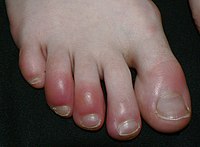Chilblains

Chilblains, also known as pernio and chill burns, are a medical condition in which damage occurs to capillary beds in the skin, most often in the hands or feet, when blood perfuses into the nearby tissue resulting in redness, itching, inflammation, and possibly blisters. It occurs most frequently when predisposed individuals, predominantly women, are exposed to cold and humidity. Ulcerated chilblains are referred to as kibes. Temperature-related chilblains can be prevented by keeping the feet and hands warm in cold weather and avoiding exposing these areas to extreme temperature changes. Once the diagnosis of chilblains is made, first-line treatment includes avoiding cold, damp environments and wearing gloves and warm socks.
Chilblains can be idiopathic (spontaneous and unrelated to another disease), but similar symptoms may also be a manifestation of another serious medical condition that must be investigated. Related medical conditions include Raynaud's disease, erythromelalgia, frostbite, and trench foot, as well as connective tissue diseases such as lupus or vasculitis. In infants affected by Aicardi–Goutières syndrome (a rare inherited condition which affects the nervous system) chilblain-like symptoms occur together with severe neurologic disturbances and unexplained fevers.
Chilblain-like symptoms have also been linked to COVID-19. COVID toes, as they are commonly known, have mostly been reported in older children and adolescents, who often have not had other symptoms of COVID-19. The symptoms are usually mild and disappear without treatment. Their cause is debated: it is uncertain whether COVID toes are a delayed consequence of the viral infection itself (or at least partially connected to environmental factors during the COVID-19 pandemic). They may share some of the microscopic features of chilblains caused by lupus. It has been suggested that in the absence of exposure to cold and damp, COVID-19 should be considered as a possible cause of chilblains.
Signs and symptoms

The areas most affected are the toes, fingers, earlobes, nose.
- Blistering of affected area
- Burning and itching sensation in extremities
- Dermatitis in extremities
- Ulceration (severe cases only)
- Erythema (blanchable redness of the skin)
- Pain in affected area
- Skin discoloration, red to dark blue
Chilblains caused by exposure to low temperatures usually heal within 7–14 days.
Prevention
Exposure
- Keep affected area warm, and avoid any extreme temperature changes (including very hot water).
- Keep affected area dry.
- Wear warm shoes, socks and gloves.
- Wear a hat and a scarf to protect the ears and the nose.
- Avoid tight fitting socks/shoes.
Other
- Exercise at least four times a week to improve circulation.
- Quit smoking, as it damages circulation.
Treatment
Treatment for the condition depends on its cause. Below are some common treatments for chilblains caused by exposure to low temperatures, though some may also apply to other sources of the condition.
- A course of vitamin B, especially nicotinic acid, may improve circulation.
- Soaking in warm water with Epsom salts for 15–20 minutes, 3–4 times a day.
- A topical steroid cream may relieve itching.
- Nifedipine, a vasodilator, may help in some cases. Vasodilation may reduce pain, facilitate healing, and prevent recurrences. It is typically available in an oral pill but can be compounded into a topical formula.
- Diltiazem, a vasodilator, may help.
- Apply a mixture of friar's balsam and a weak iodine solution.
- Avoid restricting the affected area.
History
The medieval Bald's Leechbook recommended treating chilblains with a mix of eggs, wine, and fennel root, and a modern home remedy is to put garlic on the chilblains. Neither of these remedies has been supported by scientific research.
See also
- Equestrian perniosis
- Erythrocyanosis crurum
- Raynaud's disease